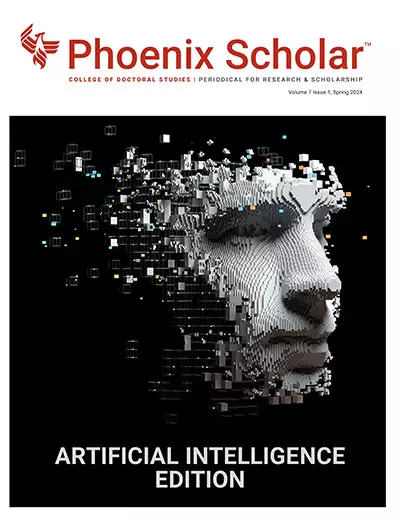Magazine
Phoenix Scholar
Journal for research & scholarship

About the Scholar
Phoenix Scholar showcases the commitment of University of Phoenix faculty, students and alumni to help foster the process of leading research through evidence-based practice. It serves as a dynamic and robust platform for sharing research results and outcomes and exploring their relationship to the broader scope of learning and scholarship.
The Phoenix Scholar is an open-access journal, which means that all content is freely available without charge to the user or his/her institution. Users are allowed to read, download, copy, distribute, print, search, or link to the full texts of the articles or use them for any other lawful purpose without asking prior permission from the publisher or the author. This is in accordance with the BOAI definition of open access. Additionally, there is no charge for researchers who seek to publish within the periodical.
Current issue

Spring 2025
Special Anthology Edition: 2024 Knowledge Without Boundaries Summit
We are excited to present this special anthology edition of the Phoenix Scholar in celebration of the 2024 Knowledge Without Boundaries (KWB) annual research summit. As a reflection of this transformative three-day research summit, this edition celebrates a period marked by curiosity, collaboration, and a collective commitment to pushing the boundaries of knowledge.
Over the course of three days, we witnessed the convergence of ideas from diverse disciplines, each presentation a testament to the power of rigorous inquiry and academic passion. This summit also underscored the importance of interdisciplinary collaboration in addressing the complex challenges of our time. It is through shared knowledge, respect for diverse methodologies, and a willingness to engage across boundaries that meaningful progress becomes possible.
What stood out most was not only the quality of research and scholarship but the spirit of dialogue that permeated every presentation and informal exchange. Students, early-career researchers, and established scholars engaged as equals in vibrant discussions, asking bold questions and offering fresh perspectives. This open, collaborative atmosphere is the beating heart of who we are, and we are proud to have cultivated a special edition that memorializes these moments.
Call for submissions
We encourage you to submit articles that summarize your presentations, best practices and contributions to the literature, as well as the practice.
The Phoenix Scholar accepts submissions for article content within and external to the university. For further details on submission criteria, see the requirements below, or you may contact the Editor, Dr. Juana Lang at vickyhavana@email.phoenix.edu or the Managing Editor Dr. Mark McCaslin at mlmccasl@email.phoenix.edu
Want to get published in Phoenix Scholar?
Past issues [2024-2023]

Fall 2024
Volume 7, Issue 2
In an era of significant global challenges, the call for transformative research and practice has never been more urgent. The Fall 2024 edition of Phoenix Scholar delves into the advancements reshaping our understanding of the world and fostering innovative solutions.

sPRING/SUMMER 2024
Volume 7, Issue 1
This issue offers a number of perspectives on AI's potential to enhance teaching methodologies, streamline classroom processes, and the possibility to catalyze groundbreaking research endeavors.
Winter 2023/2024
Volume 6, Issue 3
In this Special Proceedings Edition, we’ve assembled the peer-reviewed presentation abstracts from the 2023 KWB Summit, including the 2023 College of Doctoral Studies "Dissertation of the Year" winners and a special interview with the KWB Keynote Speaker Dr. Cheryl Lentz.
Archived editions
Creative Commons Licensing and Copyright
Phoenix Scholar © 2017 is licensed under CC BY 4.0
Note for faculty in California
This is a non-compensable activity. Participation in College of Doctoral Studies calls for proposals and activities are not job related, there is no benefit or detriment to participation, no unwritten expectation that you participate, and no critical work information will be conveyed.



